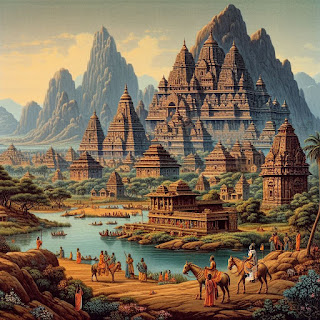Ancient India
The Early Man
The fossils of the early human being have been found in Africa about 2.6 million years back, but there are no such evidence in India. So, it appears that India was inhabited.
Later than Africa. The recent reported artefacts from Bori in Maharashtra suggest that the appearance of human beings in India was around 1.4 million years ago.
The Stone Age has been divided into.
- The Palaeolithic or Old Stone Age
- The Mesolithic or Middle Stone Age
- The Neolithic or New Stone Age
The Palaeolithic Age (500000 BC - 9000 BC)
·
The Palaeolithic culture
of India developed in the Pleistocene period or the ice age.
· It seems that Palaeolithic men belonged to the Negrito race. Homo Saplens first appeared towards the end of this phase.
This age is divided into three phases.
· Early or Lower
Palaeolithic - The earliest stone tools, such as choppers and hand
axes, were created during this time period.
·
Middle Palaeolithic - During this time, increasingly advanced stone tools, such
as flake tools and projectile points, were developed.
·
Upper Palaeolithic - During this time, art evolved, including cave paintings
and sculptures, as did the use of more complex stone tools like blades and
burins.
The Mesolithic Age (9000 BC - 4000 BC)
Microliths, which are small tools made of stone, were made.
They were used for many things, like hunting, fishing, and gathering.
People were able to move more easily and see new places
when boats and canoes were invented.
People began to live in permanent or semi-permanent settlements,
which led to the growth of settled towns.
As people began to raise plants and animals as pets,
agriculture grew.
Some of the most famous
Mesolithic Age sites in India are:
Bhimbetka is in the state of Madhya Pradesh. This place is known for its rock paintings, which show animals, people, and shooting scenes.
Bagor, Rajasthan: This spot has shown that people in India
have been farming for a long time.
Burzahom, Kashmir: This place
has shown that people have lived in Kashmir for a long time.
The Neolithic Age (4000 BC – 1800 BC)
The Neolithic Age, also
called the "New Stone Age," started around 10,200 BC and finished
around 2,000 BC. It is known for the growth of farming, the taming of animals,
and the use of polished stone tools. During the Neolithic Age, people started
living in permanent groups and making their societies more complicated.
Some of the most important
things about the Neolithic Age are:
Agriculture: The Neolithic Age was
characterised by the growth of farming. People started to tame plants and
animals, which helped them make more food and settle down in one place.
Settled communities: The rise of settled
communities was made possible by the growth of agriculture. People no longer
had to move around to find food, and they could build homes and towns that
were there to stay.
Social complexity: As the Neolithic Age
went on, social systems became more complicated. To farm and raise animals,
people had to work together, which led to the creation of governments, rules,
and other institutions.
Art and culture: During the Neolithic
Age, new types of art and culture grew. People started making pots, jewellery,
and other things to decorate their homes. They also came up with new faith
ideas and ways of doing things.
During the Neolithic Age, people learned how to make pots, weave, and work with metal for the first time. People were able to make better goods and trade with other countries because of these technologies.
Chalcolithic Culture
The Chalcolithic age, also
called the Copper Age, was the time between the Neolithic and Bronze Ages. It
was a time of change for people. It is known for the growing use of copper and
other metals, as well as the growth of farming and horse husbandry.
In India, some of the most
important Chalcolithic tribes are:
The Ahar or Banas culture, which thrived in the Malwa area
of central India, was based on agriculture.
The Deccan Plateau was the home of the Kayatha people.
The society of Malwa, which was in the western part of
India.
The people of the Jorwe society, who lived on the Deccan
Plateau.
Here are some of the most
interesting things about India's Chalcolithic culture:
Copper and brass were used for the first time in India by
the Chalcolithic people. They used these metals to make tools, weapons, and
decorations.
Pottery: The Chalcolithic people made unique pottery that
was often painted with geometric shapes.
People in the Chalcolithic were farmers and took care of
their animals. They raised animals like cattle, sheep, and goats and grew crops
like wheat, barley, and rice.
People in the Chalcolithic lived in small towns and
villages. Most of the places they lived were near rivers or other water
sources.
Religion: The Chalcolithic people had many different ideas
about religion. They honoured the gods and goddesses of nature and also
honoured their dead.
The Chalcolithic culture
was a very important part of India's past. It was a time of a lot of change and
new ideas, and it set the stage for the later societies of India in the Bronze
Age.
Important sites
Rajasthan, Maharashtra, West Bengal, Bihar, Madhya Pradesh
etc.

.png)



